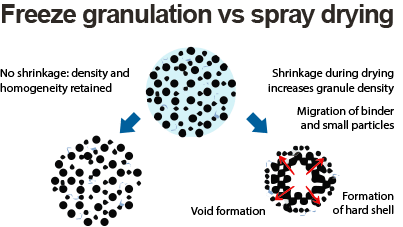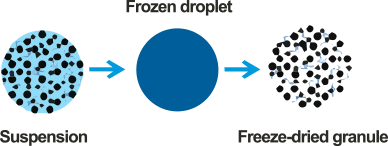
Pros and cons

Colloidal approach for pressing
Idea to lock and transfer suspension homogeneity into granules

Advantage of Freeze Granulation compared with Spray Drying
- The granule density can be controlled (solid content of the slip)
- No cavities (voids) in the granules
- No migration of small particles and/or binder gives a high degree of granule homogeneity
- Nanopowders and enzymes can be granulated and dried into a powder and then re-dispersed to nanopowders again avoiding agglomeration (aggregates) of nanoparticles, which is not possible with other granulation methods like spray drying
- Low temperature granulation and drying of pharmaceuticals, drugs, biomaterials and fine chemicals, quick and easy to redispers
- A mild drying procedure minimises oxidation of non-oxides and metals
- Lower granule density and evenly distributed pressing aids gives softer granules and ensure that all granules are broken during compaction
- Low waste of material (high yield)
- Not only large quantities but also very small experimental batches 50–100 ml slip) can easily be processed
- The equipment is easy to clean (allows the use of latex as binder)
- Possibility of recycling organic solvents
Disadvantages of Freeze Granulation compared with Spray Drying
- Two process steps: spray freezing and freeze drying
- Limitation in the choice of solvent, based on the freezing properties – a freezing point between –20 and +10 °C is recommended (water and cyclohexane)
- Large-scale equipment with a capacity beyond 100 kg granules per day needs to be further developed
